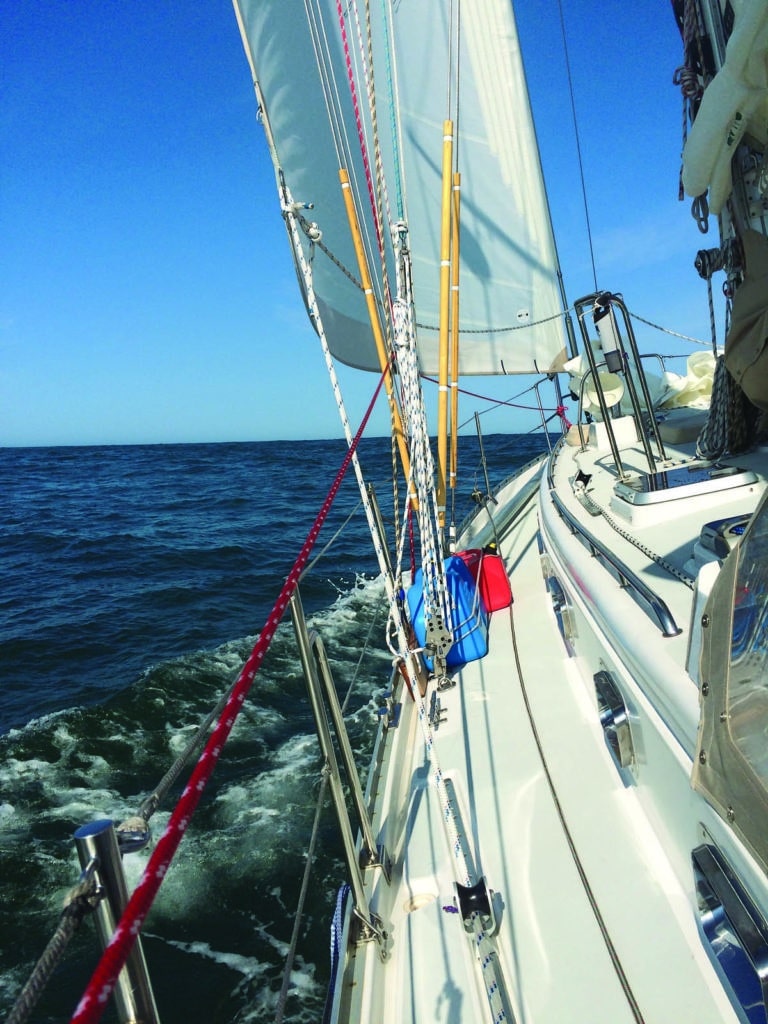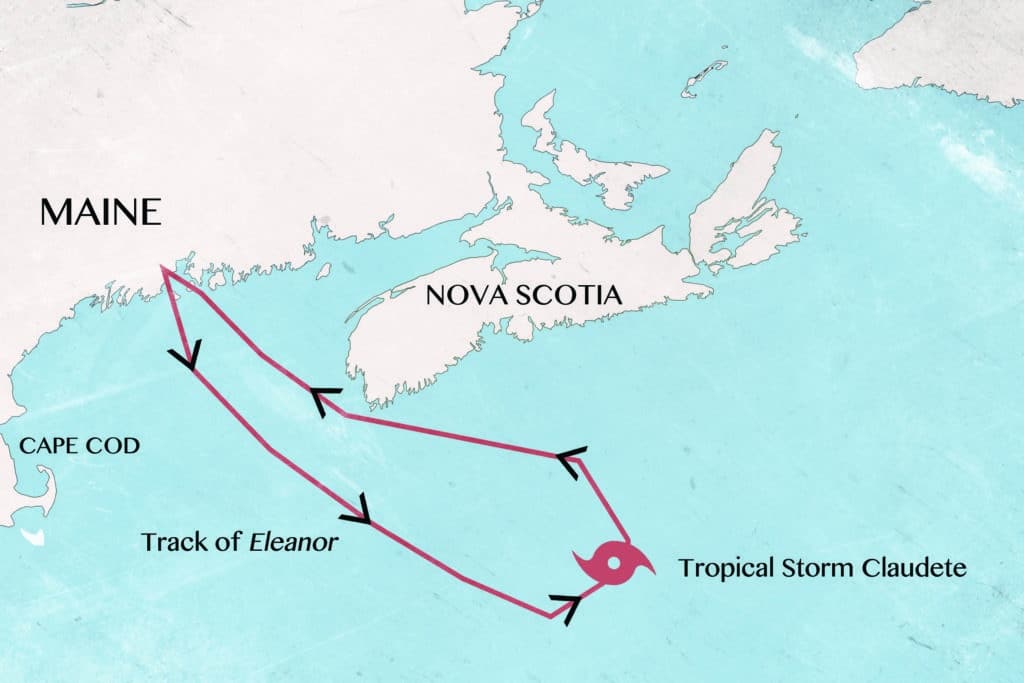Part 5: Wednesday July 15 – Saturday July 18
The morning after the storm, I awoke to discover that Logan and Billy had scrapped the Halifax plan and were sailing directly back to Belfast, a distance of roughly 380 nautical miles. It was a long trip, but there were some nice moments, including a sighting of the French tall ship Hermione under full sail, on her summer-long tour of the East Coast and Canadian Maritimes. And the Milky Way was sensational — as bright, white and well-defined as the stripe down a skunk’s back.
I tried one final time to log on to the Internet via the KVH system, but was unsuccessful. Only later, when I could get back online, did I learn why. We’d apparently purchased less than a week’s worth of satellite time. But in a classic Catch-22 scenario, we didn’t get the warning from the provider, because we couldn’t open email. Perfect.
The final bit of excitement came as we closed the coast of Maine and snagged a lobster pot. Logan was able to cut it free. But when he tried to put the engine back in gear, it wouldn’t engage. It turned out that the shift cable had been poorly installed, which gave him the opportunity to make one last repair. It might’ve been the last straw if we hadn’t already drawn it.
By Friday afternoon we were tied back up at Front Street. Our course on the YB tracker we’d carried told the tale. In the end, our voyage from Belfast to Belfast turned out to be a great circle after all.
i knew a lot of folks would be wondering what happened, so as soon as we had cell coverage, I posted a photo and update to my Facebook page. Part of it read as follows: “The great Pablo Neruda once wrote, ‘I need the sea because it teaches me,’ and I certainly learned some harsh lessons this trip.”
I received dozens of supportive comments, including these:
“The safest maneuver is the 180-degree turn. The Atlantic will be there.”
“Better that stuff happened sooner than later, when farther out.”
“Safe and wiser. Not a bad day.”
“There are no excuses to be made for trying. Only in not.”
I appreciated all the kind thoughts. And I still felt awful about the entire thing.
Plus, I knew I’d have to write about it all, a task I was already dreading. I decided to interview Hasse and Logan, just to make sure I understood their perspectives about what had transpired. As always, they were wise and insightful.
“We all know as sailors that the key thing we have to be is flexible, and we didn’t have that flexibility, none of us,” said Hasse. Like Logan and me, she lamented all the time we’d spent getting the sat comms working at the expense of other projects that would’ve been more useful. That whole thing had been a stupendously lousy idea.
“All in all we had some great tools, but we didn’t have the time to set them up properly,” she said. “And I know Dave. He just keeps going and fixing things and making things work. I knew from talking with him that he really felt there were too many things that weren’t as they should be.”
Logan had some interesting thoughts about the differences in the North Pacific and the North Atlantic. “In the Pacific, you get a pattern that comes in from four to seven days at a time. They’re big systems, and they move slowly. If you’re in a lot of wind, you know you’re going to have it for several days. And here, we went from zero to 40 knots and back to zero in a matter of hours. Just the speed at which things develop and change, it’s interesting.”
Finally, we all agreed on one thing: The ocean trip we’d just taken should’ve been the real shakedown for a transatlantic voyage. We’d discovered what went wrong, what worked and what didn’t. We should’ve gone home, corrected things and set out when we were actually prepared. Simple, right?
Then Hasse asked me if I planned to chat with Billy. It hadn’t occurred to me. Of course, she was right.
It was an odd session. When I asked Billy about the decision to turn back, he said, “I was unhappy about it. I heard panic on board when all that was going on in the storm.” (I was tempted to ask how he’d heard anything from his bunk down below, but let that one go. Then again, I too had missed a few comments, like when Billy shouted at Logan, during the height of the blow, “Why are you trying to break my boat?!”)
“I’ve been in water like that before. I didn’t think it was that big a deal,” he added. “Let’s get on with the program. But I’d also say Logan was pretty critical to the operation, in terms of being able to assess problems and solve them, in terms of also having a deep level of understanding about how some of these systems work, what you can and can’t do and can and can’t expect. Logan’s input was important. It’s been important to this mission all along. So when Logan ankles, when he says, ‘I don’t want to do this anymore,’ you’ve got to listen to that.”
The panic comment seriously irked me. I certainly understood that other mistakes were made. But on this score, Billy was dead solid wrong. Looking back — and this might speak to the general preposterousness of the entire enterprise — our handling of the storm was actually the most challenging, interesting and even fun part of the whole misadventure. We addressed it flawlessly. It was certainly the only time during the entire trip that I felt completely focused and on top of my game.
Billy also told me a more pertinent story, about his mountaineering exploits. He’d hired guides on numerous expeditions, not all of them successful for many reasons. “So I have tasted this kind of disappointment on many occasions,” he said. “I’ve been weathered out, and I’ve had my own personal failures. Many climbs, fewer summits. This is just another one of those.”
It struck me that Logan, Hasse and I had been just like those guides. Billy had been our client. Throughout our trip, I’d been amazed that he’d not been more involved with the process — had not, to my eye at least, embraced the voyage or the experience of going to sea. It’s been said the journey is often the destination. But from what I’d seen of Billy, the destination was the destination, a checkmark on a bucket list. Actually sailing there was just something that had to be endured to achieve the desired result.
Billy wrapped up our chat by saying he’d be trying again next year, and he planned on rounding up some Islesboro sailors who “really know these waters.” He said he was seriously considering taking one of John Neal’s sail-training voyages beforehand — an especially good idea — and added, “I’m going to get this done.”
I’m rooting for you, Billy.
One last notable thing happened on our final day together. In a Belfast diner with Hasse and Logan that morning, as the waitress poured coffee, she said, “So, are you guys going to the Celtic Festival?” The Celtic Festival?! No. Way.
After breakfast, we wandered down to the local park in the cool, damp morning — a New England day by the river, but right out of the distant moors. I could barely believe my eyes. Men in kilts surrounded us; droning bagpipes provided the soundtrack.
Son, I thought to myself, you cannot make this shit up.
After wandering through the open-air booths, among the T-shirts and knit goods, the three of us made a collective, spur-of-the-moment decision: We would buy Billy a kilt. Twenty bucks apiece sealed the deal. Nope, we didn’t get the man to Scotland. But we’d bring a swatch of Scotland to him.
That night, on Eleanor, over our last round of Dark ‘n Stormies, we presented it to him. I have to admit, after the entire disheartening experience, he was an amazingly good sport about it. Hell, he’d been the one with the real skin in the game.
Billy pulled the kilt on over his jeans; the bloody thing fit perfectly. He did a half-step, smiled broadly, posed for pictures.
No lie — the man could absolutely rock a kilt.
He looked, well … great.
Herb McCormick is CW’s executive editor and the author of As Long As It’s Fun, the award-winning biography of Lin and Larry Pardey.










